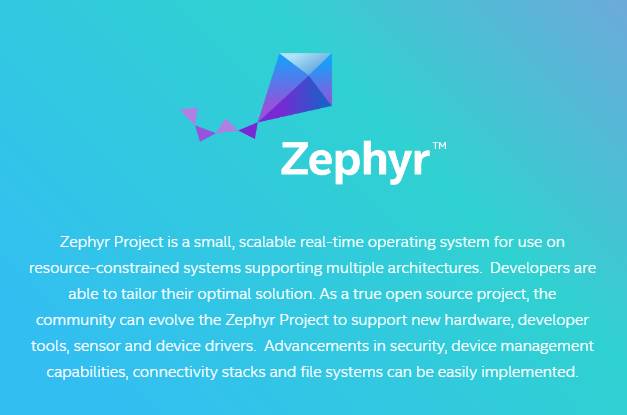
Source: Zephyr
IoT Think Tank Organized and Released
Please indicate the source and origin when reprinting
—— [Introduction] ——
The newly released open-source Zephyr Project™ is a small real-time operating system that supports multiple architectures, designed specifically for IoT (Internet of Things) gateways and edge applications, making it an ideal choice for developing applications based on microcontroller sub-Linux.

The newly released open-source Zephyr Project™ is a small real-time operating system that supports multiple architectures, designed specifically for IoT (Internet of Things) gateways and edge applications, making it an ideal choice for developing applications based on microcontroller sub-Linux. Zephyr is very suitable for running on the smallest microcontroller-based applications, including single “smart” sensors, with a wide range of uses.
The Best Choice for ‘Lowest Memory Usage’ Devices
Zephyr means a gentle breeze, and it also refers to various delicate and lightweight things. Just as its literal meaning, the Zephyr operating system is expected to bring a breath of fresh air to the developer community, ensuring that developers can navigate with the wind at their backs. The Zephyr Project is a small but scalable operating system that allows developers to customize the optimal solution based on it. This operating system is particularly suitable for resource-constrained systems and supports multiple architectures, including Intel® architecture (IA).
Zephyr is a genuine open-source project, fully open to the developer community. Developers can modify the system to support new hardware, tools, sensors, and device drivers, including continuously improving security, device management features, connectivity stacks, and file systems.
Released by the Linux Foundation
The Linux Foundation is dedicated to helping developers build ecosystems to accelerate the development and commercialization of open-source technologies. It is currently working to create a shared technology library and expand any open-source project by providing tools and conducting training and events. The Linux Foundation recently announced the launch of the Zephyr Project.
Why choose the Zephyr Project? The reason is that while Linux is an excellent embedded development operating system, IoT devices need a real-time operating system (RTOS) that can support the smallest memory footprint. Thus, the Zephyr Project was born. This operating system features scalability, focuses on security, and supports seamless connectivity. It is a highly modular platform that can easily integrate third-party libraries and embedded devices of any architecture. Therefore, the Zephyr Project is a strong complement to real-time Linux, making it very suitable for working in conjunction with data acquisition systems, manufacturing equipment, and all types of time-sensitive instruments and machines.
Intel: One of the Early Supporters of the Zephyr Project
Intel, including the acquired Altera Corporation and Wind River, has been involved in the Zephyr Project since its announcement on February 17. The early partners of this project include NXP Semiconductors N.V. (including the recently acquired Freescale), Synopys, Inc., and UbiquiOS Technology Limited.
Intel recently launched three completely new enhanced features for the Intel® IoT Developer Kit, including support for pairing with IoT gateways. The first is the Intel® System Studio (ISS) IoT version, which supports C++ and Java development on Intel IoT gateways running Wind River operating systems. The second includes new features and support functions in the Intel® XDK IoT version for developing Javascript applications and HTML5 companion applications.
Meanwhile, Intel also announced that the Intel® System Studio for microcontrollers supports the open-source Zephyr Project, allowing the project to support Intel architecture as well as many other architectures.
Mark Skarpness, Vice President of Embedded Operating Systems Engineering at Intel Open Source Technology Center and Director of Software and Services Division, stated: “Intel believes that the Zephyr Project will have a significant impact on the interconnected and embedded device market. By providing a scalable, customizable, secure, and open-source operating system, the Zephyr Project will meet the evolving needs of connected device development. We plan to work with the Zephyr community to develop a world-class operating system to drive innovation.”
Follow the official WeChat account of the Zephyr Project by scanning the QR code below


Hi, I am IoT101!
About the Internet of Things,
Every word I say is not nonsense;
If you encounter any IoT-related problems,
Don’t call 110,
Just come here and check with IoT101!